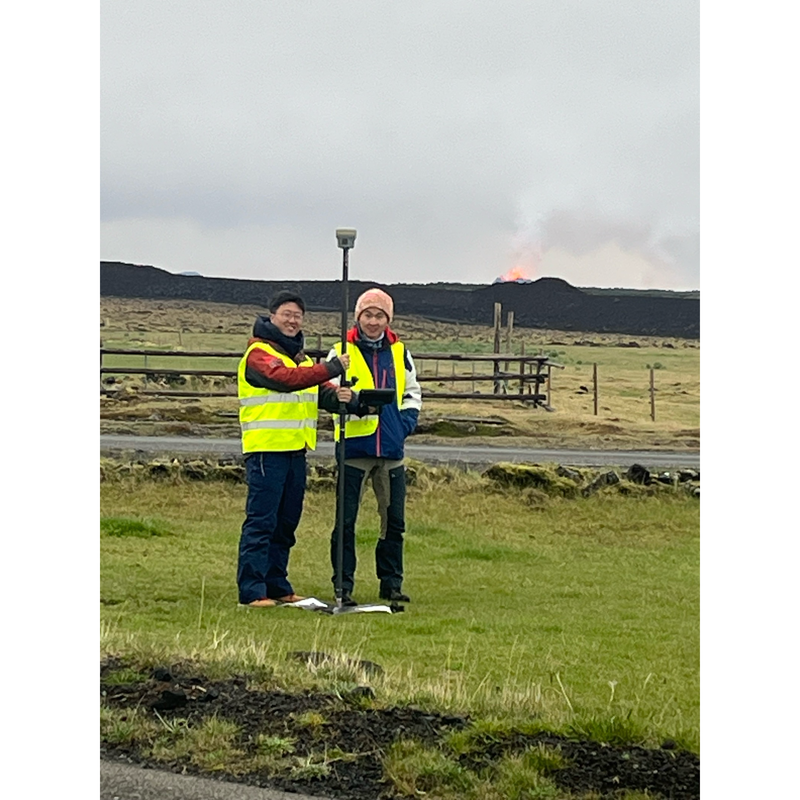## Lava Lamp 2.0: Can Fibers Save Us From the Next Big Boom?
Volcanoes. Earth’s fiery breath, a breathtaking spectacle of raw power. But behind the awe-inspiring eruptions lies a potential for devastation. Predicting these eruptions, however, has been like trying to decipher smoke signals – a risky game of chance.

From Data to Alert: Developing a Volcanic Forecasting System

The deployment of distributed acoustic sensing (DAS) technology, developed at Caltech, in the Reykjanes Peninsula at Iceland’s southwestern edge has opened up new avenues for volcanic forecasting. By leveraging the power of DAS to study the motion of subsurface magma and its eruption into lava on the surface, researchers have been able to develop a method to provide warnings up to 30 minutes in advance of lava eruptions.
The study, led by Professor Zhongwen Zhan, demonstrates the potential of DAS in providing early warnings to the public, thereby saving lives and minimizing damage to property. The research has significant implications for volcanic monitoring and early warning systems, highlighting the need for more advanced and accurate methods to predict volcanic activity.
DAS works by pointing lasers into unused underground fiber-optic cables, measuring the phase change in the laser light as vibrations pass through the cable. This method allows for the precise measurement of underground movement on the order of millimeters in real time, a much higher resolution than GPS or satellite imaging.
During the study, DAS collected data on underground volcanic activity, monitoring how the Earth stretches in real time as magma moves around. The team developed a preliminary early-warning system that gave the public between 30 minutes to several hours of advance notice before an eruption, depending on the nature of the magma intrusion.
The study’s findings have significant implications for volcanic monitoring and early warning systems. By leveraging the power of DAS, researchers can develop more accurate and reliable methods to predict volcanic activity, thereby saving lives and minimizing damage to property.
Early Warning Systems: A Lifesaver for Communities
Early warning systems are critical for saving lives and minimizing damage to property during volcanic eruptions. The deployment of DAS technology in the Reykjanes Peninsula has provided a valuable tool for developing early warning systems.
The study’s findings demonstrate the potential of DAS in providing early warnings to the public. By leveraging the power of DAS, researchers can develop more accurate and reliable methods to predict volcanic activity, thereby saving lives and minimizing damage to property.
The early warning system developed by the team provided warnings up to 30 minutes in advance of lava eruptions. This is a significant improvement over traditional methods, which often provide warnings only after the eruption has occurred.
The deployment of DAS technology has significant implications for volcanic monitoring and early warning systems. By leveraging the power of DAS, researchers can develop more accurate and reliable methods to predict volcanic activity, thereby saving lives and minimizing damage to property.
A Lifeline for Communities: The Impact of Early Warnings on Safety
The impact of early warnings on safety during volcanic eruptions cannot be overstated. Early warning systems have been shown to save lives and minimize damage to property.
The study’s findings demonstrate the potential of DAS in providing early warnings to the public. By leveraging the power of DAS, researchers can develop more accurate and reliable methods to predict volcanic activity, thereby saving lives and minimizing damage to property.
The early warning system developed by the team provided warnings up to 30 minutes in advance of lava eruptions. This is a significant improvement over traditional methods, which often provide warnings only after the eruption has occurred.
The impact of early warnings on safety during volcanic eruptions is significant. By providing early warnings, communities can take necessary precautions to minimize damage to property and save lives.
Bridging the Gap: Combining DAS with Traditional Monitoring Methods
The deployment of DAS technology has significant implications for volcanic monitoring and early warning systems. By leveraging the power of DAS, researchers can develop more accurate and reliable methods to predict volcanic activity, thereby saving lives and minimizing damage to property.
The study’s findings demonstrate the potential of DAS in providing early warnings to the public. By combining DAS with traditional monitoring methods, researchers can develop more accurate and reliable methods to predict volcanic activity.
The deployment of DAS technology has the potential to revolutionize volcanic monitoring and early warning systems. By leveraging the power of DAS, researchers can develop more accurate and reliable methods to predict volcanic activity, thereby saving lives and minimizing damage to property.
Beyond Iceland: Global Applications for DAS Technology
The deployment of DAS technology in the Reykjanes Peninsula has significant implications for volcanic monitoring and early warning systems globally. By leveraging the power of DAS, researchers can develop more accurate and reliable methods to predict volcanic activity, thereby saving lives and minimizing damage to property.
The study’s findings demonstrate the potential of DAS in providing early warnings to the public. By combining DAS with traditional monitoring methods, researchers can develop more accurate and reliable methods to predict volcanic activity.
The deployment of DAS technology has the potential to revolutionize volcanic monitoring and early warning systems globally. By leveraging the power of DAS, researchers can develop more accurate and reliable methods to predict volcanic activity, thereby saving lives and minimizing damage to property.
Improving Accuracy and Reach: Future Developments in DAS
The future of DAS technology holds significant promise for improving accuracy and reach in volcanic monitoring and early warning systems. By leveraging advancements in technology, researchers can develop more accurate and reliable methods to predict volcanic activity.
Future developments in DAS technology include the deployment of more advanced sensors and the development of more sophisticated algorithms for data analysis. These advancements will enable researchers to develop more accurate and reliable methods to predict volcanic activity, thereby saving lives and minimizing damage to property.
The deployment of DAS technology has significant implications for volcanic monitoring and early warning systems globally. By leveraging the power of DAS, researchers can develop more accurate and reliable methods to predict volcanic activity, thereby saving lives and minimizing damage to property.
The Future of Volcanic Monitoring: A Paradigm Shift
The deployment of DAS technology in the Reykjanes Peninsula has marked a significant paradigm shift in volcanic monitoring and early warning systems. By leveraging the power of DAS, researchers can develop more accurate and reliable methods to predict volcanic activity, thereby saving lives and minimizing damage to property.
The study’s findings demonstrate the potential of DAS in providing early warnings to the public. By combining DAS with traditional monitoring methods, researchers can develop more accurate and reliable methods to predict volcanic activity.
The deployment of DAS technology has the potential to revolutionize volcanic monitoring and early warning systems globally. By leveraging the power of DAS, researchers can develop more accurate and reliable methods to predict volcanic activity, thereby saving lives and minimizing damage to property.
Game Changer for Disaster Preparedness: A Safer Future with Predictive Technology
The deployment of DAS technology has significant implications for disaster preparedness. By leveraging the power of DAS, researchers can develop more accurate and reliable methods to predict volcanic activity, thereby saving lives and minimizing damage to property.
The study’s findings demonstrate the potential of DAS in providing early warnings to the public. By combining DAS with traditional monitoring methods, researchers can develop more accurate and reliable methods to predict volcanic activity.
The deployment of DAS technology has the potential to revolutionize disaster preparedness globally. By leveraging the power of DAS, researchers can develop more accurate and reliable methods to predict volcanic activity, thereby saving lives and minimizing damage to property.
Conclusion
So, there you have it, folks. Fiber-optic technology, a mainstay in our increasingly digital world, is poised to become a crucial tool in predicting one of nature’s most awe-inspiring, yet terrifying displays: volcanic eruptions. By monitoring minute changes in the Earth’s crust, these sensitive sensors can act as an early warning system, giving communities precious time to prepare and evacuate. This isn’t just about saving lives; it’s about protecting infrastructure, economies, and ecosystems from the devastating impacts of volcanic activity. Imagine a future where volcanic eruptions are no longer a sudden, catastrophic surprise. Where the rumble beneath our feet becomes a whisper, a signal picked up by these invisible sentinels. The implications are profound. Not only can we minimize the human cost of these events, but we can also gain invaluable insights into the inner workings of our planet. This technology could revolutionize our understanding of plate tectonics, magma flow, and the intricate processes that shape our world. As we delve deeper into this fascinating frontier, one thing is clear: the future of volcano monitoring is brighter, safer, and more connected than ever before.
